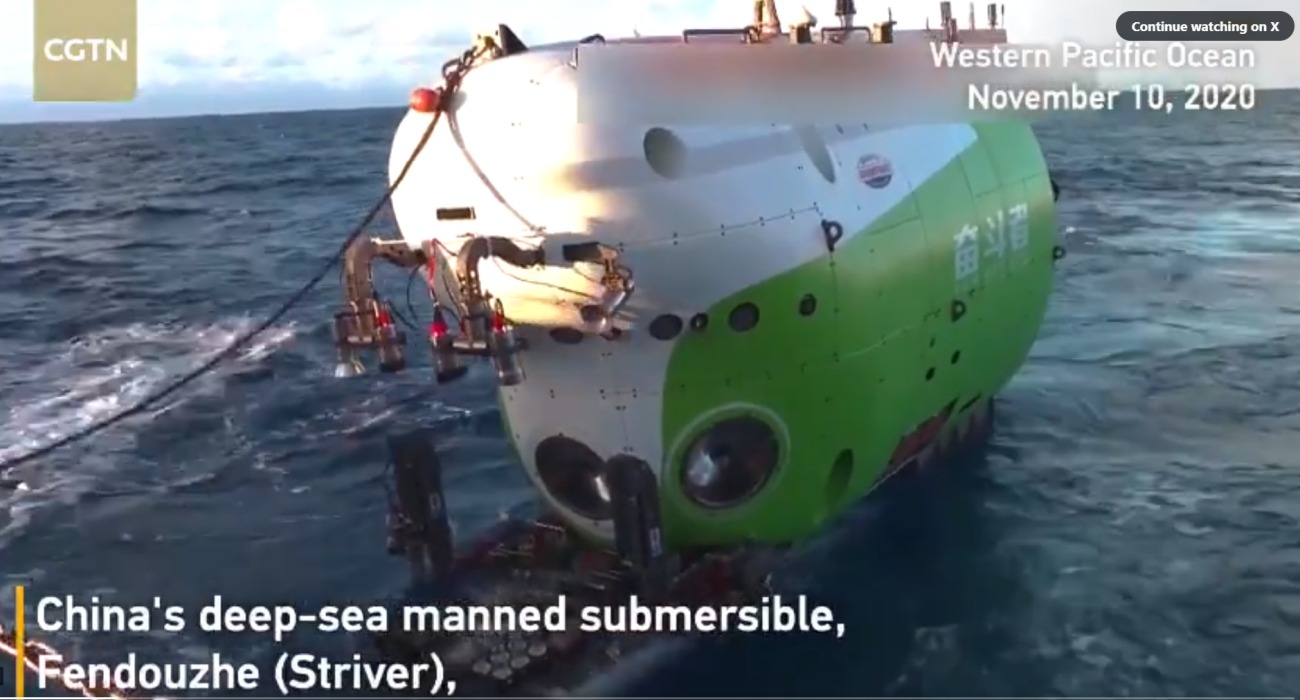The Fendouzhe (Striver) is China’s first manned submersible that can operate at the bottom of the sea, said the chief designer of the submersible vessel. It has been hailed as a demonstration of China’s scientific and technological innovation.
The chief designer, Ye Cong, a member of the 14th National Committee of the Chinese People’s Political Consultative Conference (CPPCC), was speaking at the “Members’ Corridor” on the fringes of the “Two Sessions,” CGTN reported.
Ye informed reporters, “The Fendouzhe has dived 230 times into the ocean in the previous four years.” “We accumulated a great amount of precious data, which will be a foundation for human research of the deep sea.” The vessel can transport three individuals to the lowest point in the ocean.
He said three Chinese submersibles had completed more than half of the world’s deep-diving missions in the previous three years. The other two Chinese submersibles along with the Fendouzhe (The Striver) are the Jiaolong (Flood Dragon) and the Shenhai Yongshi (Deep-sea Warrior), which have managed to hog the limelight.
China’s deep-sea manned submersible, Jiaolong, completed its first dives in the Atlantic last month. By February 23, Jiaolong had explored several hydrothermal zones over 23 successful dives in the southern Atlantic.
In the mission, about 300 biological and geological samples were gathered, in addition to 4 gigabytes of environmental data and visual elements.

Using manned submersibles, marine scientists can observe and collect samples of creatures in their native environments while conducting investigations in the fields of biology, chemistry, geochemistry, geology, and geophysics. These small vehicles rely on research vessels for upkeep, dive preparation, transportation, related equipment, operators, and scientists researching at the study location.
The need for manned submersibles is projected to persist in science despite the remarkable advancements in unoccupied vehicle capabilities, including autonomous and remotely operated models. China appears to have taken it upon itself to emerge as a leader in deep-sea exploration. The Fendouzhe, along with its two sister ships, is aiding that effort.
Fendouzhe, A Chinese Marvel
Fendouzhe shot to fame in 2020 when it dived into the deepest underwater valley in the world, Mariana Trench. China live-streamed footage of the submersible parked at the bottom of the trench.
Three researchers were on board the Fendouzhe, which sank more than 10,000 meters, or roughly 33,000 feet, into the submarine trench in the western Pacific Ocean, according to state broadcaster CCTV. The green-and-white Chinese submersible was shown sailing through murky water with clouds of silt surrounding it as it gradually made landfall at the bottom.
The achievement was seen as exemplary given that few people have ever set foot on the bottom of the Mariana Trench, a crescent-shaped depression spanning more than 2,550 kilometers and deeper than Mount Everest in the Earth’s crust.
With this, China effectively investigated the region known as the “fourth pole of the Earth,” which is also one of the planet’s most hostile environments.
China's deep-sea manned submersible, Fendouzhe (Striver), successfully landed on the bottom of the #MarianaTrench, the deepest one on earth. Its depth of 10,909 meters is equivalent of the height of the #MountEverest and #MountHua added together. pic.twitter.com/SudJX22W1A
— Lijian Zhao 赵立坚 (@zlj517) November 10, 2020
The vessel has also undertaken some significant joint missions. One such mission was in 2022 when, for the first time, two manned submersibles, the Fendouzhe and the Shenhai Yongshi (Deep-sea Warrior), operated together on assigned missions in the South China Sea at a depth of 1,500 meters.
The Fendouzhe and the Shenhai Yongshi finished several tasks, including voice communication, target search and recovery, underwater real-time positioning, quick mobility, and collaborative activities.
The cooperative effort additionally enabled a mother ship supporting scientific research to ensure the concurrent diving of the two manned submersibles, thereby potentially lowering operating and maintenance expenses while simultaneously enhancing the operational efficiency and capability of Chinese submersibles.
Watch: Research plans for China's manned deep-sea submersible "Fendouzhe" unveiled pic.twitter.com/zbCrag53z5
— CGTN (@CGTNOfficial) March 16, 2021
China’s Fendouzhe deep-sea manned submersible created history by operating for ten straight hours at the deepest point of the Diamantina Trench in the southeast Indian Ocean. The scientific research ship Tansuo (Exploration)-1 was able to safely retrieve it later.
This marked the first occasion in human history that a submersible reached the trench’s lowest point, speeding up research into the trench system and being seen as crucial for the advancement of global abyssal science.
Speaking about the Fendouzhe, Ye told reporters: “In the future, we will try to contribute more to human exploration and protection of the ocean.”.
Besides its three manned submersibles, China currently operates several unmanned submersibles, including the Hailong. The nation has developed a full-depth deep submersible system in the preliminary stage and has significantly advanced deep-sea equipment technology.
- Contact the author at sakshi.tiwari9555 (at) gmail.com
- Follow EurAsian Times on Google News




